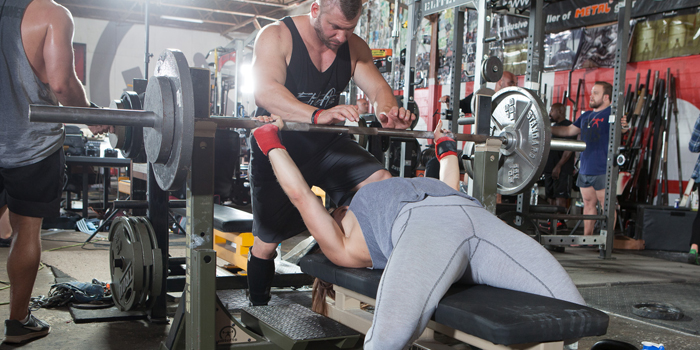
Now that the overall structure of the program is laid out, we will focus more on the progression details behind exercise prescription, variations, and the minor things that everyone is concerned about: Sets and reps.
Choosing Max Effort Variations
My opinions on picking these movements may not align with the “original conjugate” approach. I say this only because I was taught early on in my career that you don’t necessarily want to pick a max effort movement that is your weakness. Over the years of reading my peers’ articles, listening to them speak, and coming up with my own theories, I have purposely chosen max effort (ME) movements that are a struggle for the athlete. For a quick review, this is my four-week block of ME waves:
- Week 1: Max triple
- Week 2: Max double
- Week 3: Max single
- Week 4: Deload
While following the above template and keeping true to my opinion about the risk being less than the reward, I will always prescribe a weaker movement variation for a max triple. This self-regulates the athlete to strain without putting him or her at an increased risk for injury. Because it’s a movement that they are not good at, the athlete will be forced to use a lighter load. The max double will vary from client to client, but typically, it is a movement that he or she is stronger at. The caveat is that I throw in another variable to make it a little bit more difficult. For example, if the athlete is good at the safety squat bar, I’ll program that for a max double but make him or her use a box or some accommodating resistance.
RECENT: The Overall Structure of Conjuphasic
Max effort singles are usually programmed as a movement that plays to the athlete’s strengths. This allows the athlete, for lack of a better term, to “send it.” This works in my favor in two ways: First, the trend of going heavy for the gram gives the client his or her “fix” when it comes to pushing the limit during each four-week training block. Second, it allows me to see if progress was made or if the client is still failing with the same technical issues. A third hidden reason is that playing to the client’s strengths keeps him or her safer. Because it’s a stronger movement for the client, they will most likely be more technical and maintain a better position during a strain. I look at all of these variables when prescribing max effort movements for people, and that is why each person has different movements prescribed.
Accessories
Accessories are a very interesting topic for many. The theories and opinions are all over the board on how to pair and prescribe these movements along with sets and reps. My approach to this is very fundamental.
1. Most people, especially those in powerlifting, do not have enough workloads during their training to accumulate mass, especially during strength blocks. In other words, they don’t do enough accessory movements, or they fail to do the ones they need. Many lifters also fail to do enough volume (sets and reps) in their accessories.
2. Powerlifters tend to move the maximum weight all of the time. Even if they choose good accessory exercises, these exercises tend to be done poorly, resulting in specific muscle groups not being trained properly.
Because of these observations, my approach is this: On max effort days, the reps will stay consistent throughout the three-week block before the deload, but the sets will increase by one every week. For example, during week one (ME triple), all of your accessories are done with the fewest sets possible. This also allows you to push harder on those movements. By week three (ME single), your sets for accessories will be up to around five. I like this style because you’re generally taxed from the ME work. This prevents you from lifting as heavily on accessories, but it can push the volume up and cause you to focus more on isolation. (If you cannot tell by now, I love coming up with ways to self-regulate my athletes and clients through exercise prescription and programming.)
Inversely, on repetition effort and dynamic effort days, I flip these principles and keep the sets exactly the same for the three-week block but increase the reps every week. This allows for some progressive overload even if the athlete is unable to go up in weight. The reps prescribed are based on the muscle group size. On both days, reps have a tendency to be higher by the last exercise of the day.
Conditioning and Recovery
This has been a very hot topic lately. Many of the younger-generation lifters are asking about this more and more. I believe that the reason for this is that they are either getting hurt or feeling worse on a more regular basis. Ninety-nine percent of the time, they are not properly implementing all aspects involved in training. Those aspects include GPP, hypertrophy, and proper strength principles. As mentioned in my first article, I follow a block style of training. Although block periodization has its drawbacks with carrying on the attributes to the next phase, I have started to implement more conditioning into the conjugate system. I do this by inputting dynamic effort and recovery days and adding high-intensity interval training (HIIT) sessions at the end of a workout. Athletes who are more focused on powerlifting will always hate this. In contrast, athletes who have physical jobs, such as police, fire, emergency medical technician, and military work, love it, as they deal with higher heart-rate demands (metabolic stress) during their jobs. I will keep this rotation of extra HIIT work roughly eight weeks out from a meet.
So, in a nutshell, this is my approach to exercise prescription choices for max effort movements and accessory movements. These principles have shown to keep my athletes healthy and safer during a strength phase leading up to their testing on the platform. Please message below with any questions you may have, and I will do my best to further explain these topics and concepts.











1 Comment